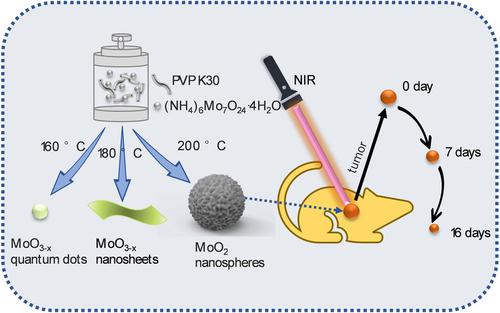当前位置:
X-MOL 学术
›
ChemNanoMat
›
论文详情
Our official English website, www.x-mol.net, welcomes your
feedback! (Note: you will need to create a separate account there.)
Morphology‐controlled Synthesis of Molybdenum Oxide with Tunable Plasmon Absorption for Phothermal Therapy of Cancer
ChemNanoMat ( IF 2.6 ) Pub Date : 2020-07-28 , DOI: 10.1002/cnma.202000311 Xiaoqin Zhang 1 , Hongru Zu 1, 2 , Yanxian Guo 3 , Qingqing Liu 4 , Zhiming Liu 3 , Chaofan Hu 1, 5
ChemNanoMat ( IF 2.6 ) Pub Date : 2020-07-28 , DOI: 10.1002/cnma.202000311 Xiaoqin Zhang 1 , Hongru Zu 1, 2 , Yanxian Guo 3 , Qingqing Liu 4 , Zhiming Liu 3 , Chaofan Hu 1, 5
Affiliation

|
Semiconductor nanocrystals showing surface plasmonic absorption features can be used as prospective substitutes for noble metallic nanoparticles. Herein, a creative one‐pot hydrothermal route without template is used to synthesize plasmonic oxygen deficiency molybdenum oxide (MoO3‐x) nanoparticles. The morphologies of as‐prepared MoO3‐x nanomaterials arranged from amorphous to crystalline with the reaction temperature varied from 160 °C, 180 °C to 200 °C, namely MoO3‐x quantum dots (QDs), MoO3‐x nanosheets, and MoO2 nanospheres. Simultaneously, in the near‐infrared region (NIR), MoO3‐x nanomaterials exhibit gradually enhanced localized surface plasmon resonance (LSPR) absorption, of which MoO2 nanospheres exhibit intense NIR absorption with a photothermal conversion efficiency up to 72.5% under 808 nm NIR laser irradiation. Moreover, the toxicity and cancer therapy efficacy of MoO2 nanospheres have been systematically assessed in vitro and in vivo, respectively. The results revealed that MoO2 nanospheres exhibit low toxicity and high therapeutic efficiency, making it an promising and effective photothermal agent in photothermal therapy
中文翻译:

形态控制合成的可调等离子体吸收的氧化钼用于癌症的热疗
表现出表面等离子体吸收特征的半导体纳米晶体可以用作贵金属纳米颗粒的预期替代物。在本文中,使用一种没有模板的创新型单锅热液路线来合成等离子体等离子缺氧氧化钼(MoO 3-x)纳米粒子。制备的MoO 3-x纳米材料的形态从无定形到晶体,反应温度从160°C,180°C到200°C不等,即MoO 3-x量子点(QD),MoO 3-x纳米片和MoO 2纳米球。同时,在近红外区域(NIR),MoO 3-x纳米材料表现出逐渐增强的局部表面等离子体共振(LSPR)吸收,其中MoO 2纳米球表现出强烈的NIR吸收,在808 nm NIR激光照射下的光热转化效率高达72.5%。而且,已经分别在体外和体内系统地评估了MoO 2纳米球的毒性和癌症治疗功效。结果表明,MoO 2纳米球毒性低,治疗效率高,使其成为光热疗法中有希望和有效的光热剂。
更新日期:2020-07-28
中文翻译:

形态控制合成的可调等离子体吸收的氧化钼用于癌症的热疗
表现出表面等离子体吸收特征的半导体纳米晶体可以用作贵金属纳米颗粒的预期替代物。在本文中,使用一种没有模板的创新型单锅热液路线来合成等离子体等离子缺氧氧化钼(MoO 3-x)纳米粒子。制备的MoO 3-x纳米材料的形态从无定形到晶体,反应温度从160°C,180°C到200°C不等,即MoO 3-x量子点(QD),MoO 3-x纳米片和MoO 2纳米球。同时,在近红外区域(NIR),MoO 3-x纳米材料表现出逐渐增强的局部表面等离子体共振(LSPR)吸收,其中MoO 2纳米球表现出强烈的NIR吸收,在808 nm NIR激光照射下的光热转化效率高达72.5%。而且,已经分别在体外和体内系统地评估了MoO 2纳米球的毒性和癌症治疗功效。结果表明,MoO 2纳米球毒性低,治疗效率高,使其成为光热疗法中有希望和有效的光热剂。











































 京公网安备 11010802027423号
京公网安备 11010802027423号